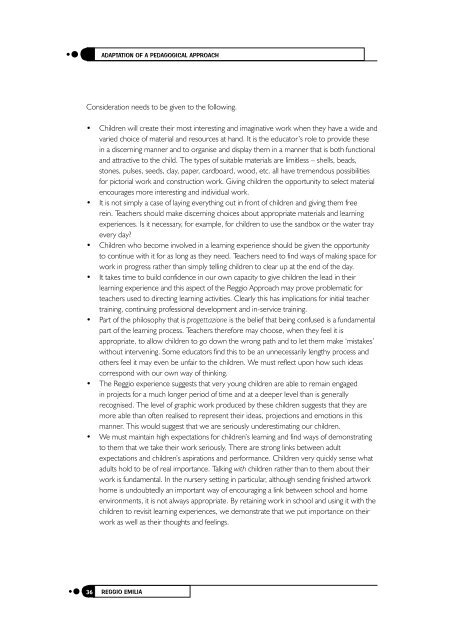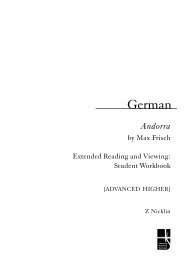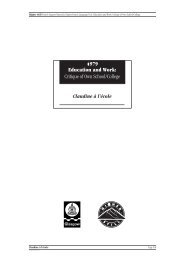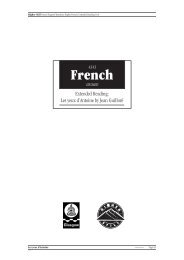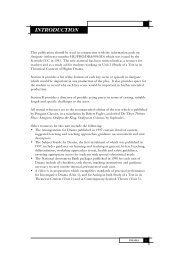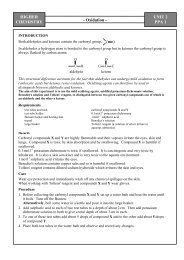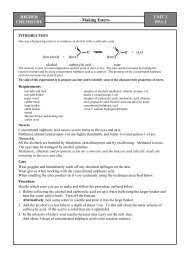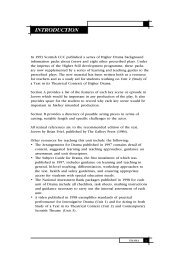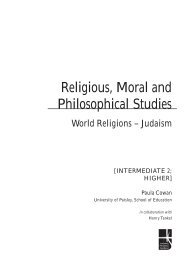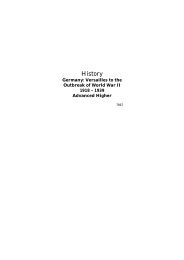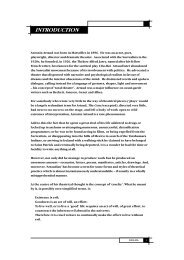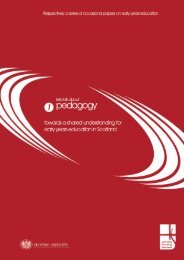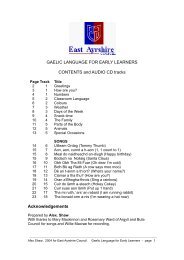The Reggio Emilia Approach to Early Years - Education Scotland
The Reggio Emilia Approach to Early Years - Education Scotland
The Reggio Emilia Approach to Early Years - Education Scotland
Create successful ePaper yourself
Turn your PDF publications into a flip-book with our unique Google optimized e-Paper software.
ADAPTATION OF A PEDAGOGICAL APPROACH<br />
Consideration needs <strong>to</strong> be given <strong>to</strong> the following.<br />
• Children will create their most interesting and imaginative work when they have a wide and<br />
varied choice of material and resources at hand. It is the educa<strong>to</strong>r’s role <strong>to</strong> provide these<br />
in a discerning manner and <strong>to</strong> organise and display them in a manner that is both functional<br />
and attractive <strong>to</strong> the child. <strong>The</strong> types of suitable materials are limitless – shells, beads,<br />
s<strong>to</strong>nes, pulses, seeds, clay, paper, cardboard, wood, etc. all have tremendous possibilities<br />
for pic<strong>to</strong>rial work and construction work. Giving children the opportunity <strong>to</strong> select material<br />
encourages more interesting and individual work.<br />
• It is not simply a case of laying everything out in front of children and giving them free<br />
rein. Teachers should make discerning choices about appropriate materials and learning<br />
experiences. Is it necessary, for example, for children <strong>to</strong> use the sandbox or the water tray<br />
every day?<br />
• Children who become involved in a learning experience should be given the opportunity<br />
<strong>to</strong> continue with it for as long as they need. Teachers need <strong>to</strong> find ways of making space for<br />
work in progress rather than simply telling children <strong>to</strong> clear up at the end of the day.<br />
• It takes time <strong>to</strong> build confidence in our own capacity <strong>to</strong> give children the lead in their<br />
learning experience and this aspect of the <strong>Reggio</strong> <strong>Approach</strong> may prove problematic for<br />
teachers used <strong>to</strong> directing learning activities. Clearly this has implications for initial teacher<br />
training, continuing professional development and in-service training.<br />
• Part of the philosophy that is progettazione is the belief that being confused is a fundamental<br />
part of the learning process. Teachers therefore may choose, when they feel it is<br />
appropriate, <strong>to</strong> allow children <strong>to</strong> go down the wrong path and <strong>to</strong> let them make ‘mistakes’<br />
without intervening. Some educa<strong>to</strong>rs find this <strong>to</strong> be an unnecessarily lengthy process and<br />
others feel it may even be unfair <strong>to</strong> the children. We must reflect upon how such ideas<br />
correspond with our own way of thinking.<br />
• <strong>The</strong> <strong>Reggio</strong> experience suggests that very young children are able <strong>to</strong> remain engaged<br />
in projects for a much longer period of time and at a deeper level than is generally<br />
recognised. <strong>The</strong> level of graphic work produced by these children suggests that they are<br />
more able than often realised <strong>to</strong> represent their ideas, projections and emotions in this<br />
manner. This would suggest that we are seriously underestimating our children.<br />
• We must maintain high expectations for children’s learning and find ways of demonstrating<br />
<strong>to</strong> them that we take their work seriously. <strong>The</strong>re are strong links between adult<br />
expectations and children’s aspirations and performance. Children very quickly sense what<br />
adults hold <strong>to</strong> be of real importance. Talking with children rather than <strong>to</strong> them about their<br />
work is fundamental. In the nursery setting in particular, although sending finished artwork<br />
home is undoubtedly an important way of encouraging a link between school and home<br />
environments, it is not always appropriate. By retaining work in school and using it with the<br />
children <strong>to</strong> revisit learning experiences, we demonstrate that we put importance on their<br />
work as well as their thoughts and feelings.<br />
REGGIO EMILIA


